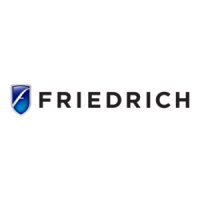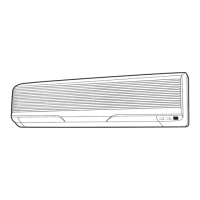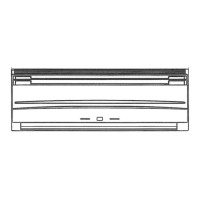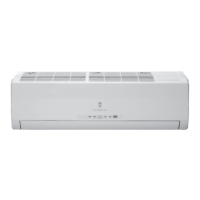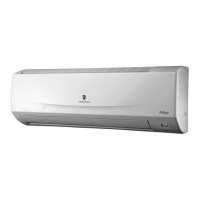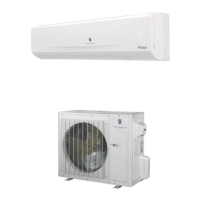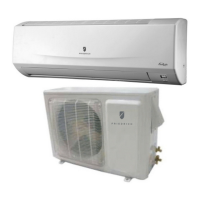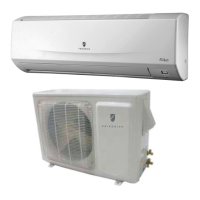Why is my Friedrich Air Conditioner producing water from the outdoor unit?
- TTamara HayesSep 13, 2025
During heating operation, water may be produced from the outdoor unit of your Friedrich air conditioner due to automatic defrosting operation.
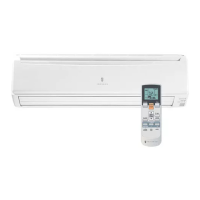
Why is my Friedrich Air Conditioner producing water from the outdoor unit?
During heating operation, water may be produced from the outdoor unit of your Friedrich air conditioner due to automatic defrosting operation.
| Noise Level | 54/51/48 dB (High/Med/Low) |
|---|---|
| Refrigerant | R-410A |
| Power Cord Length | 6 ft |
| Voltage | 230V |
| Fan Speeds | 3 |
| Height | 16 5/8 inches |
| Operating Voltage | 230V |
| Type | Window |
| Cooling Capacity | 18, 000 BTU/h |
Utilizes high power initially, then low power for economy and comfort.
Limits current and suppresses power consumption for energy saving.
Automatically switches between cooling, dry, and heating to maintain set temperature.
Maintains room temperature at 50°F to prevent it from falling too low.
Integrates OFF and ON timer operations into a single sequence within 24 hours.
Automatically adjusts thermostat during sleep for comfort and energy saving.
Provides convenient control over air conditioner operations.
Explains horizontal cooling and downward heating airflow for optimal comfort.
Enables 3D air direction control with up/down and left/right swing functionality.
The intake grille is removable for simple cleaning and upkeep.
Air filter treated to resist mildew, offering cleaner air and easier maintenance.
Reduces indoor unit airflow for quieter operation when 'QUIET' mode is selected.
An optional wired remote controller is available for enhanced control functions.
Details components of the indoor air conditioning unit.
Details components of the outdoor air conditioning unit.
Details components and functions of the remote controller.
Steps to turn on the air conditioner by activating the circuit breaker.
Guide on how to load batteries into the remote controller correctly.
Procedures for setting the current time on the remote controller.
Guidelines for effective remote controller operation and signal reception.
Steps for installing the remote controller holder and placing the unit.
Guide to initiating air conditioner operation and choosing the operating mode.
How to adjust the desired room temperature using the remote control.
Steps to select the appropriate fan speed for desired airflow.
Information on engaging the SUPER QUIET mode for reduced operational noise.
Procedure to halt the air conditioner's operation.
Details on the AUTO mode's automatic selection of heating, cooling, or dry functions.
Explains the operational characteristics of Heating, Cooling, Dry, and Fan modes.
Guide for setting the automatic ON or OFF timer functions.
How to set a program timer for combined ON and OFF operations.
Details on the program timer's ability to integrate ON and OFF operations sequentially.
Procedure to cancel active timer settings and revert to normal operation.
Steps for modifying previously set timer configurations.
Method to manually stop the unit during active timer operation.
How to modify operational settings like mode and fan speed after timer setup.
Guide to activating the SLEEP timer for automatic thermostat adjustments.
Steps for modifying the previously set sleep timer values.
Procedure to cancel the SLEEP timer and resume normal operation.
Method to manually stop the unit while the SLEEP timer is engaged.
Details on how the SLEEP timer automatically adjusts the thermostat for user comfort.
Guide for adjusting the vertical airflow direction using the remote control.
Guide for adjusting the horizontal airflow direction using the remote control.
Recommended airflow direction settings for optimal heating and cooling/dry performance.
Steps to activate the swing operation for automatic airflow direction movement.
Procedure to stop the swing operation and revert to the prior setting.
Explains the functionality of up/down, left/right, and combined swing operations.
Steps to activate the economy operation mode for reduced energy consumption.
Procedure to deactivate the economy operation and resume normal mode.
Information on how economy operation conserves energy and modifies performance.
Steps to activate minimum heat operation for maintaining a specific temperature.
Procedure to stop minimum heat operation and revert to normal mode.
Notes regarding minimum heat operation, including conditions where it may not function.
Guide for operating the unit using main controls when the remote is lost or unavailable.
Steps for removing and cleaning the air conditioner's intake grille.
Guide for removing, cleaning, and reinstalling the air filter.
Checks for issues when the unit fails to operate immediately or produces noise.
Troubleshooting steps for addressing unusual odors from the air conditioner.
Explains mist/steam emission during cooling/dry or heating operations.
Troubleshooting for weak or stopped airflow in heating, cooling, or dry modes.
Explains why water may be produced from the outdoor unit during heating.
Checks for power supply problems, blown fuses, or tripped circuit breakers.
Checks for filter issues, blocked ports, incorrect settings, and open windows.
Checks for SUPER QUIET setting and remote battery status.
Details heating performance and its dependence on outdoor temperature.
Explains the automatic defrosting function during low outdoor temperatures.
Information on the unit's automatic restart capability after a power interruption.
Details timer resetting and potential malfunctions from electrical interference.
Specifies operating temperature and humidity ranges for cooling, dry, and heating modes.
Specifies the type of air conditioner model.
Lists the specific model numbers for indoor and outdoor units.
Details the power requirements, including voltage and frequency.
Provides cooling capacity, input power, and current ratings.
Provides heating capacity, input power, and current ratings.
